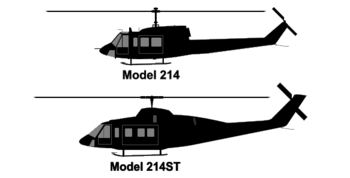Bell 214ST: Difference between revisions
| Line 23: | Line 23: | ||
==Design and development== |
==Design and development== |
||
The Bell 214ST (originally for "Stretched Twin", later "Super Transporter") has a |
The Bell 214ST (originally for "Stretched Twin", later "Super Transporter") has a 18 passenger capacity and two 1625 shp GE CT7-2A engines. |
||
The 214ST was originally developed as a military project from the Bell 214B BigLifter, specifically for production in [[Iran]] and the development by Bell was funded by the Iranian government.<ref name="Apostolo">Apostolo, Giorgio: ''The Illustrated Encyclopedia of Helicopters'', page 54. Bonanza Books, New York, 1984. ISBN 0-517-439352</ref> The interim prototype was first flown in February 1977 in [[Texas]].<ref name="Green">Green, William: ''Observers Aircraft'', page 228. Frederick Warne Publishing, 1991. ISBN 0 7232 3697 6</ref>, with three conforming prototypes following in 1978. |
The 214ST was originally developed as a military project from the Bell 214B BigLifter, specifically for production in [[Iran]] and the development by Bell was funded by the Iranian government.<ref name="Apostolo">Apostolo, Giorgio: ''The Illustrated Encyclopedia of Helicopters'', page 54. Bonanza Books, New York, 1984. ISBN 0-517-439352</ref> The interim prototype was first flown in February 1977 in [[Texas]].<ref name="Green">Green, William: ''Observers Aircraft'', page 228. Frederick Warne Publishing, 1991. ISBN 0 7232 3697 6</ref>, with three conforming prototypes following in 1978. |
||
Revision as of 01:31, 16 January 2008
The Bell 214ST medium-lift twin helicopter is derived from the ubiquitous UH-1 Huey series, and is the largest helicopter ever built by Bell. Though it shares a type number with the somewhat-related Bell 214, the 214ST is larger and of quite different appearance.
Design and development
The Bell 214ST (originally for "Stretched Twin", later "Super Transporter") has a 18 passenger capacity and two 1625 shp GE CT7-2A engines.
The 214ST was originally developed as a military project from the Bell 214B BigLifter, specifically for production in Iran and the development by Bell was funded by the Iranian government.[1] The interim prototype was first flown in February 1977 in Texas.[2], with three conforming prototypes following in 1978.
The overthrow of the Shah in 1979, lead Bell to change production plans and build the 214ST at their Dallas-Fort Worth facility instead and launch it as a civil helicopter, rather than a military one.[1] The military variant followed the civil one into production with deliveries commencing in 1982.[2]
The Bell 214ST introduced some ground-breaking innovations for Bell, including:
- a one-hour run-dry transmission
- fibreglass rotor blades
- elastomeric rotorhead bearings
- the option of skid or wheeled landing gear[1]
Bell built a total of 100 214STs. The military version deliveries included 45 that went to Iraq in 1988,[3] one to Brunei, 11 to Peru, nine to Thailand and four to Venezuela. Production of the 214ST was completed in 1991.[2]
Operational history
Excluding those in Iraq, about 39 214STs remain in use, some in the service of oil companies where the long range and twin engines are good for off shore work.
Operators
Military operators
Civil operators
- Air Logistics (part of the Bristow Group)
- Helicopter Transport Services, Inc.
- Presidential Airways
Specifications (214ST)

Data from The International Directiory of Civil Aircraft[3]
General characteristics
- Crew: 2
- Capacity: 18 passengers or equivalent cargo
Performance
References
- ^ a b c Apostolo, Giorgio: The Illustrated Encyclopedia of Helicopters, page 54. Bonanza Books, New York, 1984. ISBN 0-517-439352
- ^ a b c Green, William: Observers Aircraft, page 228. Frederick Warne Publishing, 1991. ISBN 0 7232 3697 6
- ^ a b Frawley, Gerard: The International Directory of Civil Aircraft, 2003-2004, page 44. Aerospace Publications Pty Ltd, 2003. ISBN 1-875671-58-7
See also
Related development
Aircraft of comparable role, configuration, and era
